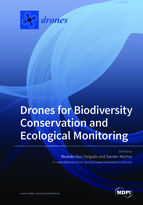Drones for Biodiversity Conservation and Ecological Monitoring
A special issue of Drones (ISSN 2504-446X).
Deadline for manuscript submissions: closed (31 October 2018) | Viewed by 131448
Special Issue Editors
Interests: multi and hyperspectral remote sensing for monitoring vegetation, wetlands and landscape changes; multitemporal analysis of remote sensing images; predictive mapping of species habitat distribution; landscape dynamics and interactions with wildfire regimes; plant regeneration trends under different disturbance regimes
Special Issues, Collections and Topics in MDPI journals
Interests: biodiversity; geographical information systems; landscape ecology; remote sensing; monitoring; land use; geoinformation; habitats
Special Issue Information
Dear Colleagues,
Unmanned Aerial Vehicles (UAV) have already become an affordable and cost-efficient tool to quickly map a targeted area for many emerging applications in the arena of Ecological Monitoring and Biodiversity Conservation. Managers, owners, companies and scientists are using professional drones equipped with high-resolution visible, multispectral or thermal cameras to assess the state of ecosystems, the effect of disturbances, or the dynamics and changes of biological communities inter alia. We are now at a tipping point on the use of drones for these type of applications over natural areas. UAV missions are increasing but most of them testing applicability. It is time now to move to frequent revisiting missions, aiding in the retrieval of important biophysical parameters in ecosystems or mapping species distributions.
This Special Issue aims at collecting UAV applications contributing to a better understanding of biodiversity and ecosystem status, threats, changes and trends. We welcome submissions from purely scientific missions to operational management missions, evidencing the enhancement of knowledge in:
- Essential Biodiversity Variables and Ecosystem Services mapping
- Ecological Integrity parameters mapping
- Long-term ecological monitoring based on UAVs
- Mapping of alien species spread and distribution
- Upscaling ecological variables from drone to satellite images: methods and approaches
- Rapid risk and disturbance assessment using drones
- Ecosystem structure and processes assessment by using UAVs
- Mapping threats, vulnerability and conservation issues of biological communities and species
- Mapping of phenological and temporal trends
- Habitat mapping, monitoring and reporting of conservation status
Dr. Ricardo Díaz-Delgado
Dr. C.A. Mücher
Guest Editors
Manuscript Submission Information
Manuscripts should be submitted online at www.mdpi.com by registering and logging in to this website. Once you are registered, click here to go to the submission form. Manuscripts can be submitted until the deadline. All submissions that pass pre-check are peer-reviewed. Accepted papers will be published continuously in the journal (as soon as accepted) and will be listed together on the special issue website. Research articles, review articles as well as short communications are invited. For planned papers, a title and short abstract (about 100 words) can be sent to the Editorial Office for announcement on this website.
Submitted manuscripts should not have been published previously, nor be under consideration for publication elsewhere (except conference proceedings papers). All manuscripts are thoroughly refereed through a single-blind peer-review process. A guide for authors and other relevant information for submission of manuscripts is available on the Instructions for Authors page. Drones is an international peer-reviewed open access monthly journal published by MDPI.
Please visit the Instructions for Authors page before submitting a manuscript. The Article Processing Charge (APC) for publication in this open access journal is 2600 CHF (Swiss Francs). Submitted papers should be well formatted and use good English. Authors may use MDPI's English editing service prior to publication or during author revisions.







